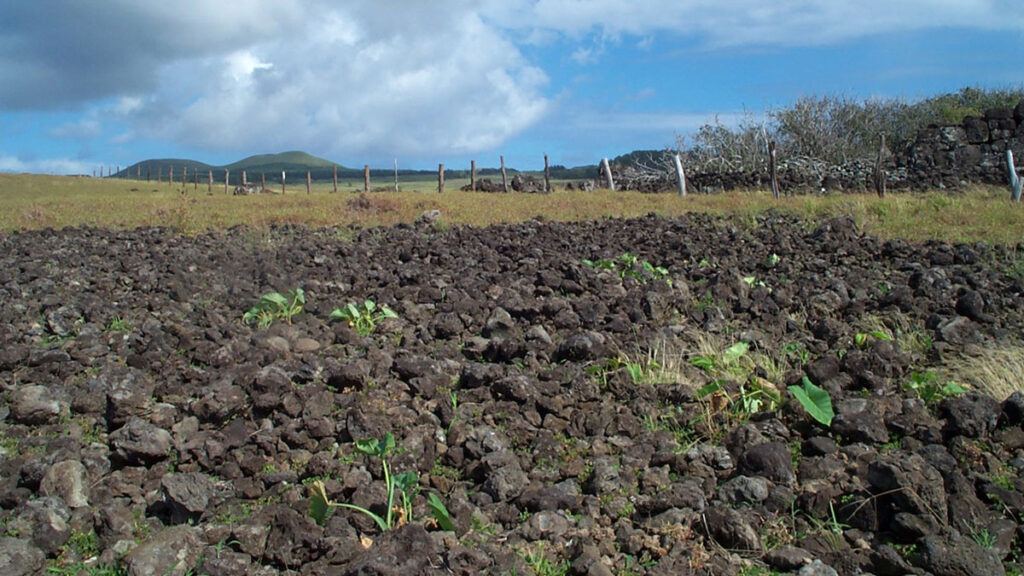Historians and archeologists debate what led to the decline of Polynesian society on Rapa Nui. Although one popular narrative holds that the creation of the famous Easter Island statues depleted resources and led to environmental collapse, more recent research indicates that collapse began when Europeans brought disease and conflict. Whatever the case, Polynesians on Rapa Nui never reached the levels of agricultural productivity seen on an archipelago settled around the same time: Hawai‘i.
According to new research, small size and isolation might have set up Rapa Nui for failure from the beginning. Researchers knew that by the time Polynesians arrived, Rapa Nui’s soils were probably already less fertile than those on Hawai‘i. Now, analysis of soil samples has shown that an important fertilizer—dust blown over from Asia—doesn’t even reach the isolated island (now a part of Chile, more than 3,500 kilometers away on the South American mainland). This finding could help researchers better understand the environmental challenges faced by ancient Polynesians. Oliver Chadwick, a soil scientist at the University of California, Santa Barbara, will present his team’s findings on 16 December at AGU’s Fall Meeting 2021.
A Story Stored in Soil
“What archeologists love about the Pacific is you get historically related people in a bunch of different settings.”
“What archeologists love about the Pacific is you get historically related people in a bunch of different settings,” said Thegn Ladefoged, an archeologist with the University of Auckland in New Zealand. “Hawai‘i has relatively big islands and a lot of environmental variation, and Rapa Nui is very much smaller and more isolated.”
Polynesians who settled Hawai‘i at least 1,000 years ago found rich soils near active volcanoes where they could easily grow crops such as taro and sweet potato. Hawaiian society flourished.
When Polynesians reached Rapa Nui around the same time, however, the story went differently. The soils on the island were poor, and the Rapa Nui people developed rock gardens: plots of land with piles of volcanic rock. The porous rocks, quarried from long-extinct volcanoes on the island, would have helped the soil retain moisture.

Chadwick, Ladefoged, and others determined that by the time humans arrived on Rapa Nui, heavy rains had already leached many nutrients from the soil. The new soil analysis shows that Rapa Nui also lacks traces of mica, quartz, and rare earth minerals that don’t naturally occur in volcanic rock. Hawaiian soils contain these minerals thanks to continental dust blown in from Asia. “The bottom line is that the results suggest that there is virtually no detectable dust in Rapa Nui,” Chadwick said.
This new insight provides “a major contribution to the study of the island, both its history and for the future sustainability of current Rapa Nui communities,” said Robert DiNapoli, an environmental archeologist at Binghamton University, State University of New York who was not involved in the research.
Although the new analysis didn’t turn up evidence of dust, the scientists did find some interesting isotopes present in the rock gardens but not the surrounding soil. These isotopes of phosphorus (an important soil nutrient) were chemically similar to those found in ancient agricultural plots in Hawai‘i.
Perhaps, Chadwick said, Rapa Nui farmers broke up volcanic rocks and carried them to these gardens to act as a sort of fertilizer. This theory supports the idea that people on Rapa Nui found a way to make the most of the environment they had, for a time.
—Rachel Fritts (@rachel_fritts), Science Writer
This news article is included in our ENGAGE resource for educators seeking science news for their classroom lessons. Browse all ENGAGE articles, and share with your fellow educators how you integrated the article into an activity in the comments section below.



